Top Story: Health
Smoking out an LGBT foe
November 14, 2013
With gay men, lesbians and bisexuals firing up far more frequently than heterosexual Californians, health officials are moving to create effective anti-smoking campaigns to persuade LGBT smokers that quitting is smart, community-minded and even sexy.
One project, being rolled out by the Los Angeles County Department of Public Health later this month, plans to take an edgy “break up with tobacco” message into gay bars and clubs.
Meanwhile, the state has released an anti-smoking video aimed at the LGBT community. The video, which shows a couple of handsome young gay men leaving a bar together, doesn’t just target smoking—it also emphasizes the importance of saying no to second-hand smoke. When one of the men starts to light a cigarette outside the bar, the other gently pushes it away from his lips as a voice-over announcer says: “It’s time to speak up. We have to protect each other.”
Nationally, the Centers for Disease Control and Prevention have showcased a lesbian bartender in the widely-watched “Tips from Former Smokers” national tobacco education campaign. The ads feature real people discussing the painful and at-times disfiguring effects of tobacco. Ellie, the bartender, never smoked herself but started having asthma attacks after years of exposure to second-hand smoke on the job.
It’s not the first time that public health officials have tried to confront the problem. Several years ago, for instance, Los Angeles County provided grant funds to several clinics to conduct LGBT-oriented smoking cessation programs. That campaign’s tagline: “Learn how to quit smoking without being scared straight. (As if you could be.)”
But a strongly-entrenched LGBT smoking culture remains, even as overall smoking rates in California have dropped over the past three decades.
Statistics released in June by the state Department of Public Health’s Tobacco Control Program show that gays, lesbians and bisexuals are more than twice as likely to smoke as heterosexuals—27.4%, compared to 12.9%.
More than a quarter of gay men smoke, compared to 16% of straight men, the state found. Among lesbians, 24.4% smoke—a rate 2½ times that of heterosexual women.
What’s more, second-hand smoke is dangerously widespread. More than 40% of gays, lesbians and bisexuals reported that they sometimes allowed smoking in their homes, compared to 23.4% of heterosexuals. The state report draws on data collected in the California Adult Tobacco Study from 2005 to 2010 among self-identified gays, lesbians and bisexuals.
The reasons for the high smoking rates can be complex.
For one thing, stress can be higher in the LGBT community, sometimes compounded by issues associated with coming out or family disapproval, said Susan Cohen, health education consultant for the L.A. Gay & Lesbian Center. Perhaps even more powerful, she added, is a strong bar culture that fosters an “unfortunate partnering of cigarette smoking and alcohol,” even though indoor bar smoking is now outlawed in California.
Others note that while an overall culture of disapproval of smoking and second-hand smoke has grown in recent years, it’s been slower to take hold in the LGBT community, where tolerance is a strongly-held traditional value.
“They’re basically loath to tell other LGBTs what to do or not do…That’s what we believe is translating into a more live-and-let-live attitude toward second-hand smoke,” said Francisco Michel, a media specialist with the state Tobacco Control Program.
Another challenge is confronting tobacco industry advertising aimed at the LGBT community. While some have decried the targeting, others see it, oddly enough, as a sign of respect.
“Some folks say, ‘See, we’re just like any other market,’ ” Michel said.
That’s why health officials believe it’s important, and effective, to fight fire with fire, offering another story line—preferably one that is sophisticated and engaging—to offset Big Tobacco’s persuasive tactics.
“I do think we have to continue with counter-messaging,” said Cohen, of the Gay & Lesbian Center. “The tobacco industry spends billions to get us to smoke.”
Posted 10/31/13
‘Healthy’ shortcut to medical care
October 9, 2013
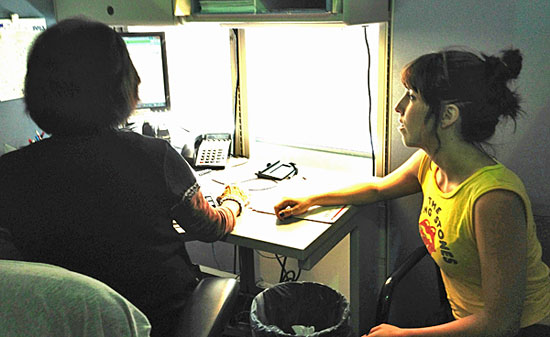
Patient Beth Goodfellow likes the Affordable Care Act, but for now, she’s relying on Healthy Way L.A.
As Californians rushed to sign up for coverage under the Affordable Care Act last week, Beth Goodfellow sat on the sidelines, too sick to join in.
A 28-year-old rock musician newly arrived in Atwater Village from San Francisco, she had planned to wait until her gigs picked up and then shop on the new state exchange for health insurance. But when a pain in her side wouldn’t go away, she found herself at the county’s Mid-Valley Comprehensive Health Care Center, unable to wait until 2014, when the Affordable Care Act kicks in in earnest.
The county’s Rx?
A primary care doctor at the Van Nuys center, and enrollment—right now—in Healthy Way L.A.
As the next phase of healthcare reform approaches a January deadline, Los Angeles County has been busily bridging the gap with its own interim program to channel the uninsured toward coverage.
Come 2014, all Americans will be required to have some form of health insurance, whether via an employer, a private purchase or the government—Medicare or Medicaid, for example.
To ease the shift, that mandate will come not only with subsidized state exchanges like the ones that opened last week to make it easier and cheaper to buy private insurance, but also with a massive expansion of the federal government’s Medicaid program for low-income patients, (or Medi-Cal, as it is known in this state).
While computer glitches with the exchanges have drawn widespread attention nationwide in the past week, Los Angeles County has continued to power ahead with a related effort: enrolling as many eligible uninsured patients as possible in a local program called Healthy Way L.A.
Created in 2007, Healthy Way L.A. isn’t technically health insurance and, except for emergency services, doesn’t cover members outside Los Angeles County. But it does offer free, publicly funded health care to the kinds of patients who mostly end up being treated by the county and community clinics—those who can’t afford private insurance, or whose jobs don’t include it.
The program covers legal residents aged 19 to 64 who earn too much to qualify for Medi-Cal right now and still make less than 133% of the federal poverty level (less than about $1,274 monthly for one person). Because all of those patients will become eligible for government-subsidized insurance under the terms of next year’s expansion, health officials are viewing Healthy Way L.A. as a quick and easy steppingstone to the new, more broad-based version of Medi-Cal.
Thousands of uninsured patients have been registered for Healthy Way L.A. at health fairs, county hospitals and health care centers and community clinics, and, as January approaches, the county has moved aggressively.
Dr. Mitchell Katz, director of the county’s Department of Health Services, told the Board of Supervisors on Tuesday that the county is well on its way toward reaching its goal of 300,000 sign-ups for the program.
Sheryl Spiller, head of the county’s Department of Public Social Services, which is playing a central role in registering people for the program, told supervisors that 275,000 already have been signed up.
“Things are moving along and we’re ready,” Spiller said.
The stakes are high, both for patients and the county.
Giving patients a fast track to insurance gets them accustomed to regular checkups at a regular location. That, in turn, helps keep them healthier and holds down healthcare costs by preventing expensive emergency room visits.
But another reason for the push is that the county wants these patients. When the Healthy Way L.A. clients transition to Medi-Cal, the federal government will begin picking up all or most of the cost of their healthcare—a tab that the county is helping to pick up currently.
Moreover, even with the Affordable Care Act, the county will remain the provider of last resort for some 400,000 undocumented residents and others who will remain ineligible for any insurance. The county will need as many covered patients as possible to stay financially afloat
So with only a couple months until January, the county is pulling out all the stops to get future Medi-Cal recipients into the pipeline.
“It’s crunch time,” said Deedra Williams, public information officer for ambulatory care at the Department of Health Services. “It’s all hands on deck right now.”
Goodfellow, the rock musician, was one of 38 new clients signed up on a single morning last week at the healthcare center in Van Nuys.
And there as elsewhere, officials say the county has been working on its bedside manner, because under Medi-Cal, the Healthy Way L.A. clients who now get their care from county doctors and community partners will be able to shop around for healthcare.
“We’ve been serving this population for two years now, but we’re focusing on making sure that we provide quality care and good customer service,” said Tangerine Brigham, DHS deputy director of managed care services.
DHS officials say the department has been working with Spanish-language television stations to get the word out, and last week, DHS rolled out a new, much more user-friendly web site. And at Mid-Valley, Associate Administrator Linda Kim-Fung said staffers last year underwent intensive customer service training.
“We’re trying to educate our staff to go out of their way to be friendly,” Kim-Fung said. “You know—the customer comes first, be friendly, ask if there’s anything else.”
That’s a good thing, said 52-year-old Ben Ahmadi, an uninsured grocery clerk with diabetes who was renewing his Healthy Way L.A. enrollment.
“There’s nothing wrong with the doctors here,” he said. But, he added, the county system will have its work cut out for it if it wants to compete with established managed health care juggernauts such as Kaiser Permanente, where he once had insurance.
“When I used to have Kaiser, you’d go in and make an appointment and you’d be in there in around 15 minutes,” he said.
Goodfellow said she’s grateful that Healthy Way L.A. was there to cover her in the short term. In San Francisco, she said, she used a similar county health access program and was pleasantly surprised at the quality of care.
“I’m pretty young, so I just tend to go to the doctor when I don’t feel well,” she said. “But I think Obamacare is a really good idea and I’m happy we’re coming closer to having health care for everyone.”
Posted 10/8/13
Bringing the family together
September 12, 2013

A rendering of the San Fernando Valley Family Support center, which will provide a new, collaborative model for bringing government to the people.
Problems don’t always come one at a time.
When families need help for more than one reason, they often have to visit various locations and wait in lines while navigating the bureaucracies of multiple government agencies. But an innovative project in the San Fernando Valley will streamline that process by cutting the red tape in a new, state-of-the-art facility.
The San Fernando Valley Family Support Center, which breaks ground in Van Nuys on Saturday, Sept. 21, will bring seven Los Angeles County departments under one roof—in a building specially-designed to foster collaboration. Michael Samsing, who has worked on the project for the county Chief Executive Office since 1999, said the center will bring government to the people in a new way.
“It’s a one-stop location where families can access all the services that can help them,” Samsing said. Whether it’s food assistance, parenting skills or a child on probation, he said, “we’re going to get all the departments working together for the one client that comes to get services.”
This is the first time this kind of team effort has been planned from the ground up, Samsing said. Previously, departments have been co-located in a single building but didn’t fully integrate their operations, remaining separated by walls and layers of bureaucracy.
Samsing saw some of those barriers fall at meetings during which departments provided input on the project. “It was interesting to hear departments realize that they have common clients, that there are other services we can provide,” he said. “We all work in silos and this is really meant to blow that up.”
It all starts with the building—a five-story structure designed by HKS Architects, Inc. Thom Greving, the project designer, said the job reached the heart of what it means to be an architect. “People think we design buildings, but that’s secondary to what architecture really is—to craft experiences,” he said.
The design employs fewer walls and plenty of common areas, along with shared meeting rooms and group workstations in an open, campus-like environment. To create an uplifting work environment, Greving included a healthy dose of sunlight; 90% of employees will be within 30 feet of a window. The campus features walking paths, bike racks and plenty of greenery, including 380 new trees and a large, live oak as the centerpiece for the courtyard. Clients will enter a shared lobby, where they’ll check in through kiosks or greeters, Greving said.
The complex will be built on county-owned property on Van Nuys Boulevard, in an area that was found to have the highest concentration of social service cases in the valley, according to a study commissioned by the CEO in 2000. Two empty county facilities and a vacant bowling alley have been razed to make way for the new project. (The Mid-Valley Comprehensive Health Center, also located on the property, will continue to operate throughout construction and afterwards.)
The new building is targeted to achieve LEED Gold certification for environmental sustainability, but Greving said it might even make LEED Platinum, a much rarer distinction. Efficient heating and cooling systems will be installed in floors and bio-filtration gardens will serve as retention ponds to clean storm water runoff.
Each of the departments that will be housed there—Children and Family Services, Public Social Services, Child Support Services, Probation, Health Services, Mental Health and Public Health—will pay part of the $175.9 million price tag. Supervisor Zev Yaroslavsky, who has been involved in planning since the beginning, has also allocated $9.6 million to the project.
The support center also could provide much-needed economic revitalization in the area, said David Howard, who is managing its construction for the Department of Public Works. “With all the county employees and visitors,” he said, “there will be a lot of people seeking restaurants and shops.”
With construction underway, Samsing and another county CEO employee, Carlos Pineda, will focus on the operational details. Pineda is optimistic about the new environment, but he acknowledged that challenges remain. Technological incompatibilities, legal issues and requirements on how funds can be spent are all hurdles to confront. Pineda and Samsing hope their work will become a blueprint for future service, a more efficient model that will help families become aware of the full spectrum of assistance that county government can provide.
“Up until now we have been focused on the space,” Pineda said. “Now we’re figuring out how it will all work together.”
Posted 9/12/13
Carbs gone wild at the fair
September 5, 2013
It was 100 degrees at the Los Angeles County Fair in Pomona, but at Chicken Charlie’s food stand, Nelly Alvarez was hustling to keep up with demand for this year’s signature dish.
“Yep, it’s a half-pound double cheeseburger between two Krispy Kreme donuts—really,” Alvarez explained to one wide-eyed taker after another. “I hear they’re pretty good!”
Privately, however, Alvarez confessed that she actually hasn’t tried Chicken Charlie’s cheesy, meaty, sugary, gooey new 1,160-calorie item, which this week joined the fair vendor’s menu of deep-fried avocados, deep-fried pickles, deep-fried Oreos, deep-fried Kool-Aid, Krispy Kreme Sloppy Joes and other diet-busting fare. After seven years working at fair booths, she said, she now brown-bags it at her lunch breaks.
“I bring a lot of fruit, a lot of water,” she laughed, looking around to make sure no potential customers were listening. “I brought a salad today.”
Few displays evoke more mixed feelings in food- and health-obsessed Southern California than the deep-fried gluttony of the Los Angeles County Fair. In L.A., where food trucks compete with high-end juice bars, and bacon-wrapped everything vies with the pursuit of the perfect kale salad, the fair menu never fails to offer an over-the-top serving of amusement, rebellion and carbs gone wild.
“I try to be good. I try!” said Marie Thomas of Carson, wandering through a haze of Texas barbecue smoke, kettle corn and cotton candy. “But once a year? C’mon.”
After all, she pointed out, she shopped hard at the fair, which theoretically might burn off some extra calories. “So right now, I’m looking for something cheesy, something greasy and something fried.”
Los Angeles County Director of Public Health Dr. Jonathan E. Fielding, whose department has been part of a nationwide anti-obesity effort, says there’s nothing wrong with the occasional splurge. Everything in moderation—that’s essentially the theme of the county’s Choose Less, Weigh Less campaign.
“I can’t say not to go to the fair,” Fielding says, noting that he rarely misses. In fact, he said, his department plans to staff a booth there for County Day later this week.
“But I’m in favor of choice, and sometimes the choice at the fair isn’t as broad as it is in other places.” Indeed, asked how to eat at the fair and remain healthy, Fielding was hard-pressed: “Well,” he joked, “I think at one point I saw corn.”
Fair spokeswoman Renee Hernandez says some healthy food does, in fact, co-exist with the traditional extreme fair food.
“Cardinale’s Wood Fired Pizza has a pizza salad, which is a bed of romaine and mixed greens with healthy pizza toppings,” she says. “And there are chicken and shrimp kebabs.”
And, she notes, there’s Terri’s Berries, the Encinitas-based fruit stand that has been at the fair for decades.
“We get a lot of people who are happy to find us,” said Elodie Crutchfield, proffering whole fruit and baskets of berries, some of which were, shockingly, not even dipped in chocolate. “I know the ceviche stand has a mango cup, but that’s the only other healthy fruit option I know of here.”
DPH Director Fielding noted that eating something nutritious before or after a trip to the fair might work for some people. “I think you just have to choose carefully and not be easily seduced by what looks most appetizing on an empty stomach.”
But sometimes the pull is just too overwhelming.
“This looks amazing!” cried 13-year-old Daniel Chinn as donut glaze oozed onto the bright yellow cheese of his Krispy Kreme burger.
Afterward, the youngster was less enthusiastic.
“It was good,” he said, slumped at the lunch table and wearing a wan expression. “But now I feel horrible.”
Posted 9/5/13
New law serves up a cottage industry
July 18, 2013
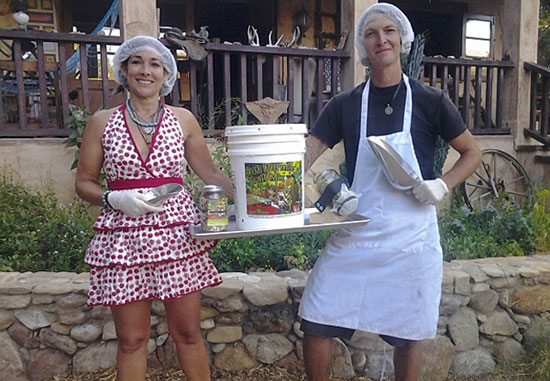
Lisa Cianci and Ben Lawson of Ant Permie's are among hundreds taking advantage of the Homemade Food Act.
Gene Holmon’s spice mix was so good that his Woodland Hills family urged him to sell it. Jessica Schnyder learned to make jam and pickles from her Hollywood chef friend, Amanda Carr.
Kyle and Liz von Hasseln, grads of Southern California Institute of Architecture, were playing with a three-dimensional printer one day when they realized they could make sugar sculptures. Shantal Derboghosian, a Van Nuys engineer, was unemployed when she discovered a gift for baking. Ben Lawson perfected his organic, sustainable trail mix in Topanga when he wasn’t drumming for a Long Beach punk/grind-crust band.
Until about six months ago, few, if any, of them could have profited much from their passions. But today, they and hundreds of others are part of an entrepreneurial boomlet ignited by a new state law allowing Californians to make food for sale from their home kitchens.
The California Homemade Food Act, which created a new category of food production called “cottage food operation,” has been in effect since January and, according to health officials, few places have seized on it with the excitement of Los Angeles County.
Spurred by L.A.’s creative culture and California’s artisanal food movement, a home-based underground of bread makers, cookie bakers, coffee roasters, marshmallow puffers, marmalade canners, baklava peddlers and just about every other imaginable kind of food purveyor has come out from behind the stove to pull permits.
“Our numbers are very high compared to other jurisdictions,” says Director of Environmental Health Angelo Bellomo, who notes that, so far, more than 500 applications have been filed with the county for permission to prepare and sell non-perishable food products at home rather than in expensive leased space in certified commercial kitchens.
Of those, he says, about 200 have been approved; most of the rest are awaiting payment of annual fees ranging from $103 to $254, depending on whether the business is direct sale only or includes sales through restaurants and markets. (Click here and here for the most recent list of permit holders.)
“There’s been a lot of interest on the part of those who have always dreamed of having a home enterprise.”
The development is no surprise to Mark Stambler, a Los Feliz artisan baker whose naturally leavened organic French bread sparked the state law in 2011 after it started flying off the shelves in local cheese shops and restaurants.
“I was selling a good number of loaves each week, and as long as I kept my head down, no one was the wiser,” says Stambler, whose bread was baked in his backyard in a wood-fired stone oven.
But over time, his bread became the talk of foodie L.A., and the Los Angeles Times ran a story, telling readers where they could find it. Within 24 hours, he says, county health inspectors descended on the shop where his goods were being sold and informed customers that it was illegal to sell food that hadn’t been prepared in a commercial kitchen.
Stambler responded with an 18-month crusade to open the system, with the help of his local state legislator, Assemblyman Mike Gatto (D-Silver Lake). The new law applies only to “non-potentially hazardous food” such as bread, preserves, dried foods and other goods whose ingredients don’t include meat, cream or other perishable items. It requires home food producers to complete a course in food processing and the labeling of their products. Those who want to sell their wares in bakeries, markets and restaurants also must undergo a kitchen inspection.
But even with the law’s limitations, the activist baker—who says he lost two-thirds of his business after the county crackdown—says he’s been thanked repeatedly for pushing the changes.
“I’ve heard from people all over the state, saying they really needed this for the added income,” he says.
The cottage food option was certainly helpful for Shantal Derboghosian, who coped with a spell of joblessness by opening Shakar Bakery out of her one-bedroom apartment in Van Nuys. Specializing in custom cakes (her business name is Armenian for “sugar”), the 31-year-old environmental engineer found herself spending six to eight hours on her creations—a labor of love if it’s in your own kitchen, but a hefty bite out of your bottom line if you have to pay an hourly rate for a commercial workspace.
“I was renting kitchen space,” she says, “but they were charging about $25 an hour and it was expensive. My first official client was a three-tier baptism cake for 150 people, with a lot of sculpting—it was a nautical thing, with whales and waves and little anchors.”
Her current project is a 5-foot-tall, flashing tribute cake modeled on the French techno-music duo Daft Punk that she created with the help of Garen Khanoyan, a fellow engineer whose day job is at the Jet Propulsion Laboratory. “These things aren’t quick to do,” she notes.
Neither is building a business, Kyle and Liz von Hasseln say, noting that the new rules have bought them crucial time to scale their custom sugar sculpting business, The Sugar Lab.
The couple says their concept was born in 2010, when they were architecture students at the Southern California Institute of Architecture downtown and a friend announced it was her birthday. “Our thesis at SCI-Arc was on new developments and free-form fabrication, which is the catchall phrase for 3-D printing,” says Kyle von Hasseln. “We were living in a teeny little apartment in Echo Park and we didn’t have an oven. So we decided to try to 3-D print her a sugar cake topper for her birthday cake.”
The idea took months of trial-and-error, he says, but eventually it yielded an extraordinary manufactured sugar sculpture that has since led to a series of custom assignments for birthday parties and weddings in collaboration with a local bakery. Their latest project? A stunning 3-D sugar diamond, done on spec for GLAAD, celebrating the U.S. Supreme Court’s same-sex marriage decision.
“We could invest in commercial kitchen space, but it would be hard for young entrepreneurs just out of grad school with a lot of debt,” he says.
For many artisans, however, the cottage food permits are simply a chance, at last, to see whether their ideas have a market.
“We love food and want to have our own business,” says Schnyder, a 26-year-old Mar Vista restaurant manager who has teamed with her 29-year-old friend Carr to launch Calliope Canned Commodities, a sideline she says expresses their enthusiasm for jams, pickles and Victorian circus musical instruments.
“What we make requires such a slow process and such small batches that you don’t need a lot of space to do it, Schnyder says. “But until now, we haven’t been able to sell it. We’ve just given it away to our friends.”
For Lawson, the drummer, the cottage food program has been a way to market not only his Ant Permie’s trail mix but also his belief in sustainability, local trade and emergency preparedness.
“We all know of local cafes that serve, you know, brownies that some old lady made in an apartment that are so good that nobody drops a dime on them,” he says. “Now that kind of thing can be legal.”
His signature organic snack is made at Cross Bull Ranch, the permaculture collective and retreat where he lives in Topanga, and is sold in airtight, rodent-proof, 5-gallon buckets that, depending on storage conditions, can keep food fresh “for months to years.”
As for Gene “Cappy” Holmon and his wife Paulette, the law has provided an answer both to those who have clamored over the years for his secret Cappy’s Dry Rub spice mix and to the retired couple’s own prayers.
“We had played with the idea for years,” says Paulette, a former costume designer. “Then this law passed, and the Heavenly Father just told us one day, ‘You guys should do something with it’.”
“Everybody seems to like it,” marvels Gene, a 66-year-old disabled veteran and retired small business owner. “Hey, we don’t play golf, so we’ve got to do something, right?”
Posted 7/18/13
Thinking big about a weighty issue
May 2, 2013
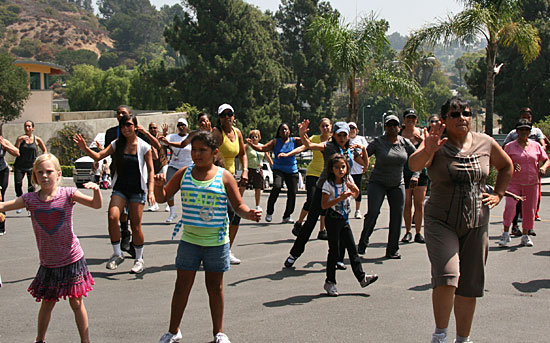
County employees and their families take the Fitness Challenge to get active and adopt a healthier lifestyle.
The county workforce is expanding—and not in a good way.
When Kaiser, the largest provider of health care to Los Angeles County workers, took a comprehensive look at employees’ vital statistics a few years back, it set off a big wakeup call at the Hall of Administration.
“The numbers were staggering to me,” said Lisa Garrett, the county’s director of personnel.
No wonder. Kaiser found that 76.7% of county employees enrolled in its plan were overweight or obese (compared to the national average of 69.2%.) What’s more, 37.3% had borderline or high cholesterol, 12.3% had high blood pressure and 7.9% were diabetic. Alarmingly, they also seemed to be passing the problem on to their kids, with 40% of enrolled employees’ children weighing in as overweight or obese as well.
“We’ve got to get ahead of it,” Garrett thought. And thus—in a partnership between Human Resources and Parks and Recreation—the Countywide Fitness Challenge was born in 2010.
As the 2013 Challenge rolls out starting this month, Garrett is adding a personal—and very public—dimension to the initiative.
At Tuesday’s Board of Supervisors meeting, she noted the large percentage of overweight county employees and declared: “I have to admit that I’m in that number. But just wait till after this year’s Countywide Fitness Challenge.”
Garrett’s UCLA cheerleading days may be a thing of the past, but she’s not afraid to get a little rah-rah when it comes to promoting fitness. And if that means going public with her intentions, so be it.
“I am coming out to say, ‘I am going to do it and you keep me honest about it,’ ”Garrett said in an interview afterward.
“I would love to get back to my college weight. I used to be a cheerleader in college. I said I’ll never see that uniform again, but I have it hanging in my closet,” she said, laughing.
Beyond that kind of motivation, there’s another powerful force at work.
“In my own family, obesity is an issue,” Garrett said. “I had a sister who had breast cancer and she passed away. My mother’s had cancer, my sister’s had a stroke. And the common thread with all three is that they were obese. So if I’m going to change that from happening to me, I’ve got to watch my weight.”
She already watches what she eats, so “I know the bottom line is going to be getting more active.”
For Garrett, like many employees, that will mean carving out time in a busy schedule.
“My day starts early and I’m here late,” she said. So she’s trying to schedule “walk and talk” late afternoon meetings that can be conducted while moving through Grand Park.
She’s also a big believer in taking advantage of all the free health testing available at Fitness Challenge events, which are held on weekends in all five supervisorial districts and are for employees, families and even pets. (Kickoff events are scheduled for May 18 at Whittier Narrows Recreation Area and May 21 at Grand Park, with other activities scheduled around the county in coming months.)
“For myself, it was at one of these events that I learned that my cholesterol range was going up,” Garrett said.
Free screenings offered include tests for glucose, blood pressure, body mass index and many others, along with fitness activities ranging from extreme boot camp to yoga, from power walking to hula hooping to Zumba.
Then there are the healthy cooking demonstrations.
“People are amazed at how delicious the food is,” Garrett said, recalling a tasty salad she sampled at one such event in Marina del Rey. “It had watermelon, fennel, mint and red onions, and it was absolutely delicious,” she said. “It has become a staple at our house because it is refreshing and healthy.”
In addition, the year-long Challenge features wellness newsletters, health fairs co-sponsored by county departments and labor groups, and the county’s popular Biggest Loser contest.
Amid all the challenges, there are some positive indicators—including the number of employees completing health assessments, in which they learn and begin tracking measurements like weight, blood pressure and cholesterol. The number of employees completing the assessments has gone from 1,502 in 2010 to 15,267 last year.
That kind of knowledge is power when it comes to preventing disease, she said.
“The bottom line is the Fitness Challenge is not a panacea for what ails us, but it will hopefully put the spotlight on the issue and the need to get more healthy as a county community. We could sit back and do nothing, but that’s not acceptable.”
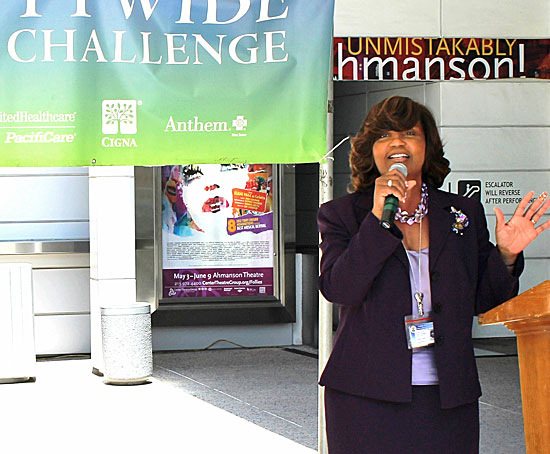
Lisa Garrett, the county's Director of Personnel, is on a mission to raise employees' fitness awareness.
Posted 5/2/13
These co-workers go the distance
March 21, 2013
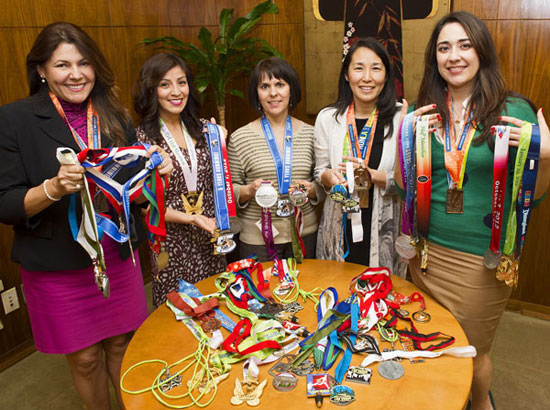
Showing off the hardware. From left, Ernestina Rhind, Salene Giron, Maria Duron, Sachi Hamai and Avianna Uribe.
Among the thousands of runners at the start of the L.A. Marathon in 2011 was a nervous but excited band of sisters. It was their first marathon, and at their side was their “mother hen,” veteran runner Sachi Hamai, more commonly known by her official title—executive officer of the Los Angeles County Board of Supervisors.
Three of the women were on Hamai’s staff. The fourth worked for Supervisor Gloria Molina. For months, Hamai would lead them on pre-dawn runs of gradually increasing distances. Before they’d even hit the streets, she’d drive the route and strategically stash water bottles so the women wouldn’t have to carry them.
After one of their sessions edged above 13 miles, Hamai, who oversees the Board of Supervisors’ agenda, came clean with an agenda of her own. “We’re going to do a marathon,” she decreed. At the close of those morning training sessions, she began urging them to visualize what it would be like to cross the finish line into the joyous and proud embrace of family and friends
Hamai was so persistent that before the starting gun was fired on the morning of the 2011 marathon, Maria Duron of the executive office remembers thinking: “What am I doing here? Did I ever say yes?” In the end, she’s forever grateful she never said no. “When we started training, I couldn’t even run a mile,” she says. “When we finished, I said, ‘We did it!’”
All five women did, in fact, finish the race, one of the most grueling in L.A. Marathon history, with rain coming down so hard that the streets were sometimes shin-deep in cold water. “I felt so horrible,” Hamai recalls. “I thought they’d never run with me again.”
She was happily wrong. Since then, the co-workers have logged countless more miles together in a ritual that the women say has created not only strong bodies, but strong bonds. “There’s a lot of chatter during our runs, but it’s not about work,” says Hamai, whose running shoes are always within arm’s reach, even when she’s at her desk. “We listen to each other about our personal lives. We push each other. If one of us says, ‘Let’s just get some coffee this morning,’ someone else will say, ‘Let’s get it after the run.’ ”
Come Sunday, 26,000 runners will once again lace up for the L.A. Marathon, a 26.2 mile journey of sweat and blisters from Dodger Stadium to Santa Monica. This time, though, the coach will be on the sidelines. “My mind is willing but my body isn’t,” Hamai says. Instead, she’ll be rooting for the sole member of the team to brave this year’s race—Avianna Uribe, operations director for Molina. “They’ll be there in spirit,” Uribe says of her training partners in the board’s executive office.
Still, Uribe will have company from a few other county colleagues along the route, including Ryan Alsop, assistant chief executive officer for intergovernmental and external affairs. This will be his fifth L.A. Marathon. But unlike the county women, he runs solo. “I’m an intense trainer and I like to be in my own head,” says the 42-year-old Alsop, whose fastest marathon time is 3 hours and 16 minutes. Although the fleet-footed exec will be running alone—heavy metal music pulsing through his ear buds—he says he’ll be joined at the starting line by a first-timer, the county’s Sacramento lobbyist, Alan Fernandes, whom Alsop convinced to give it a shot.
Fernandes, a long time cyclist and modest runner, says he thought the L.A. Marathon would be a perfect way to get a street-level view of the county he represents. “I’m using it as a sightseeing tour,” says the Northern California native. Fernandes is hoping he’ll be able to make that tour all the way from stadium to sea. His longest training run a few weeks back was 20 miles, he says, and that one “really kicked my butt. Going another six miles is going to be pretty tough stuff.”
“I’m kind of nervous,” he admits, “but I’m going to try to be calm.”
Meanwhile, Hamai is going to try to stay optimistic about her future on the roads. “It’s sad because I almost feel like I might not be able to run that far again,” she says. Last year, she and Uribe ran two marathons—Los Angeles and Chicago—and a dozen half-marathons, all of which took a toll on her body. “I just need to back off,” she says.
But, apparently, not for too long.
The other morning, Hamai and her business-attired running crew—Uribe, Duron, Salene Giron and Ernestina Rhind—gathered in her office in the Hall of Administration to display their bounty of gleaming race medals for a county photographer. Hamai noted that the sign-up for the St. George Marathon in Utah—where she ran her first marathon in 1997—was beginning on April 1.
“You can bet I’ll be trying to get into that one,” she said, and then added with a sly smile: “And I’m going to get the other girls to sign-up, too.”
(To watch the race, consider taking Metro, which has nine stations along the course. And if you’re driving, watch out for street closures.)
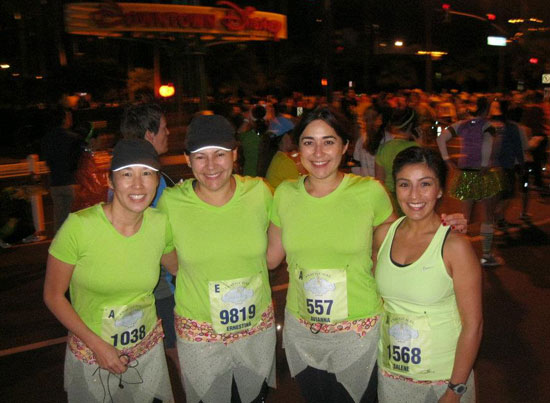
In their matching Tinker Bell costumes for a half-marathon at Disneyland, from left: Hamai, Rhind, Uribe and Giron.
Updated: Avianna Uribe and Ryan Alsop finished the marathon in fine form. But Alan Fernandes, after months of training, was unable to make the trip to L.A. from Sacramento because he was sick. Hats off also to two other marathon finishers from the county workforce: Andrew Veis, assistant press deputy to Supervisor Don Knabe, and Mark Pestrella of the Department of Public Works.
Smokers got you down? Light up a line.
February 14, 2013
So the neighbor is polluting your place with cigarette smoke. Who you gonna call?
For a growing number of Southern Californians, it’s the Los Angeles County Department of Public Health.
For years, the department’s Tobacco Control and Prevention Program has manned a phone line for complaints about those who flouted state laws against smoking, and for years, those calls mostly involved bars, restaurants and workplaces.
Lately, however, secondhand smoke wafting into apartments, condos and nursing home units has kept the line buzzing, says Tobacco Control deputy director Monty Messex. In the last six months alone, he says, 88 such complaints have come in via the Tobacco Control complaint line, far more than in past years. Forty-two percent, he added, came from the City of Los Angeles.
“It’s possible that people are smoking more in their apartments now because there are fewer and fewer places anymore to smoke in public,” Messex says, “but I think it’s more about awareness. People are realizing they have a choice.”
Smoke-free housing has become the latest frontier in the tobacco control movement, as health advocates and apartment dwellers have sought to stop secondhand smoke from drifting out of patios, balconies and neighboring units into non-smokers’ homes.
Despite arguments from some smokers and civil libertarians who view the push as an inconvenience and intrusion, California has led the charge in clearing smoke from shared living spaces. The state Department of Public Health has aired popular TV ads depicting secondhand smoke rising from vents to threaten small children, and more than two dozen jurisdictions including Santa Monica and Calabasas have adopted ordinances that restrict smoking in multi-unit housing. Last year a state law went into effect giving landlords permission to manage smoking in rental properties.
Next month, the Los Angeles County Housing Authority, which manages and owns 3,258 public and affordable housing units, is expected to seek approval on lease changes that would ban smoking within 20 feet of its buildings. Maria Badrakhan, director of the Housing Authority’s housing management division, says the move will affect some 7,000 renters from West Hollywood and Marina Del Rey to East Los Angeles and Long Beach, but so far, residents’ reactions have been overwhelmingly positive.
“We have a lot of seniors, a lot of families and people whose children have asthma, and we receive a lot of complaints from people who don’t want smoking in their buildings,” says Badrakhan, adding that the Department of Public Health has been working with the authority to help tenants quit smoking.
“We’re trying to create a better quality of life.”
The Tobacco Control complaint line—which essentially rings during business hours into the Tobacco Control and Prevention Office at 213-351-7890—is just a small part of the county’s effort to connect victims of secondhand smoke with agencies and authorities who can help.
The DPH’s Messex says it’s a challenging assignment, given the 88 separate jurisdictions and the patchwork of municipal smoking ordinances in the county. Sometimes, he says, the response is as simple as sending a letter to the property manager or owner and referring the caller to the appropriate fire department or code enforcement unit. Often, however, the county also will send callers to organizations such as S.A.F.E. (Smokefree Air For Everyone), a Granada Hills-based advocacy organization that operates an online, smokefree apartment registry.
“More and more people have come to us from the county,” says S.A.F.E.’s associate director, Marlene Gomez. “We’re getting 5 to 10 calls a week, and email in droves.”
Some of the complaints are heart-wrenching, says Gomez. “I had one case where a mother called from a rent control apartment in Wilmington with three kids—a 4-year-old, a 5-year-old and a 4-month-old baby—and the 5-year-old has asthma and smokers had moved in downstairs.”
In that case, she says, she was able to persuade the landlord to move the family to a different apartment and to let him know that he could keep smokers away in the future by specifying units as non-smoking as they became vacant.
But for many of those who complain, Messex says, recourse is limited because restrictions have yet to be enacted by the state or by most of the municipalities in the county, including the City of Los Angeles, and the bans that do exist vary from jurisdiction to jurisdiction.
“There’s not a lot we can do,” he says. “And in some cases, the situation is pretty severe.”
Apartment dwellers like Cris Borgnine say comprehensive restrictions would make a difference. Borgnine, a 46-year-old cameraman and photographer with two little boys at home, aged 3 and 7, says he started searching for help after smokers moved in not only next door, but also around the corner and downstairs from his North Hollywood apartment.
“It’s been really frustrating,” Borgnine says. “The smoke comes up through the kitchen fans and the heating ducts. When the onshore breeze blows, it comes in through our bedroom window. When you’re having dinner, it’s awful.”
In addition to his concern for his family’s health and the impact on his quality of life, Borgnine adds, his irritation had a personal angle: His father, the late actor Ernest Borgnine, had to have throat surgery at one point in his life because of complications from smoking. So when calls to the apartment manager failed to persuade his neighbors, he started dialing.
Eventually, he says, he got through to the county’s complaint line, only to learn that little could be done in his jurisdiction, other than sending his property manager a letter.
“We really need to do something about this,” he says. “Fortunately, my family and I have the resources to move to a new place, but the next person to move in is still going to have to deal with it.”
Posted 2/14/13
A passage to India
January 16, 2013
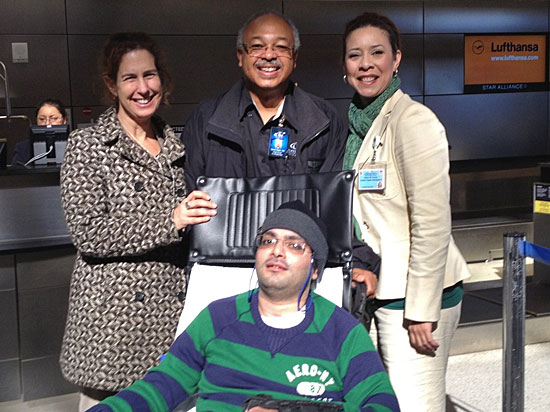
Vishal Makhija at LAX. With him are, from left, LAC+USC Social Work Supervisor Jan Crary, flight nurse David Hogan and Assistant Hospital Administrator for Medical Services Sandy Correa.
Vishal Makhija is going home.
He journeyed to Los Angeles in 2009 with dreams of becoming an accountant. Instead, he spent the past nine months at Los Angeles County+USC Medical Center—his body broken, his brain permanently damaged from a hit-and-run driver who mowed him down during an evening walk. On Wednesday morning, Makhija’s stay came to an end as he was gently lifted into a special medical transport jet bound for Mumbai, India, where his family will give him the constant care he now needs.
The $19,200 trip is being underwritten by Los Angeles County.
“Our family is middle class by Indian standards but, for us, the cost was out of the question,” says Kiran Makhija, who has lined up a nurse, a physical therapist and a specialized hospital bed in India for her 32-year-old brother. “This is a huge relief, and we are very grateful. I am 100 percent sure that Vishal will heal better and faster with family and friends who love him here.”
Makhija’s case represents an innovative effort by top county health officials to reduce hospital costs while improving patient outcomes for large numbers of hard-to-place indigent patients who are taking up public hospital beds longer than medically necessary.
Dr. Mitchell Katz, director of the county’s Department of Health Services, says he hopes to create a special fund in his budget for “creative discharges” like Makhija’s that, with some imagination, could be solved in ways that do right both by the individual patient and by the county’s limited pool of health care resources.
“Of course, each case is different,” Katz says. “There isn’t a cookie-cutter solution.” Housing and special placements have their own price tags, he notes, and sometimes the circumstances and the medical needs will make the hospital the most cost-effective decision.
“You have to look at each person and figure out what they need,” he says. “But once you’ve figured that out, if there’s a solution that’s substantially less expensive, you should be able to move on it.”
Dr. Christina Ghaly, LAC+USC’s interim chief executive, says that on any given day, approximately 10% of the hospital’s acute care medical beds, and about half of its acute care psychiatric beds, have been occupied for weeks or months by patients who should be in a lower level of care but have no provider willing to take them.
Because LAC+USC is a hospital of last resort for the impoverished, homeless and poorly insured, its rate of hard-to-place patients is far higher than that of private medical centers. At any given time, there are as many as 60 patients like Makhija, who not only increase the public hospital’s costs but also crowd out patients in need of acute beds. Some have remained hospitalized for so long that they’ve lost their housing. The county’s other three public hospitals fare little better, says Ghaly: “There’s a patient at Olive View whom we’ve been trying to place now for two years.”
Katz says he has been concerned about Los Angeles County’s high numbers of hard-to-place patients since he arrived here from San Francisco two years ago. Aside from the financial issues, he says, overlong hospitalizations can have serious medical and psychological downsides for patients, including risk of infection, atrophy and disorientation.
“When I would ask about why we weren’t sending someone to supportive housing or a board and care, or why we weren’t sending people home to be reunified with family, I was told, ‘Well, the county is in the midst of a fiscal crisis and we don’t have the budget.’ But that has never made any sense to me, because, of course, the most expensive thing to do is to keep people in the hospital.”
So the county has begun exploring alternatives, from “respite” beds where homeless convalescents can recuperate in their own bedrooms like more fortunate patients to providing financial incentives to skilled nursing facilities for taking difficult or poorly insured patients. Katz estimates that broadening the options for lower levels of care could save the county “tens of millions of dollars” while improving patient care.
The push is especially important in the wake of the federal Affordable Care Act, which promises to change the business model for health care providers by, among other things, accelerating the trend toward lump sum allotments for patients and procedures, rather than reimbursement for days in a hospital bed or fees for a medical service.
“But it’s not just about money. It’s about finding the right place for the person,” Katz says.
Finding a place for Makhija was especially frustrating because, unlike many indigent patients, his relatives were ready and willing to care for him, says interim CEO Ghaly. “The problem,” she says, “was mainly logistical.”
In fact, Makhija was planning to return to India, according to his sister. “Nothing was going right for him there,” says Kiran Makhija, an account manager for a public relations firm in Dubai.
“He used to dream, talk, visualize, live and breathe U.S.A.,” she says. “He was the biggest fan of Oprah Winfrey and would lay awake late at night watching U.S. destinations on the Travel channel.” But after spending four years in New Jersey on a visa to work and study accounting, she says, he was laid off during the 2008 financial crash and never recovered.
He moved to Los Angeles, hoping to find work, but couldn’t muster more than low-paying jobs in retail, according to Sahib Dudani, a family friend in Laguna Hills to whom Makhija had reached out. Dudani says the young man was living in a rented room in the Boyle Heights apartment, a few blocks from the site of the April 18, 2012, accident.
Hospital records show that paramedics rushed Makhija to the emergency room at 4:25 a.m. after a passerby saw him lying unconscious in an intersection near Soto Street and the I-10 Freeway. His legs were broken, his brain was traumatically injured and his body was marked with tire tracks, but no witnesses came forward and no arrests were made.
“He was coming to me [on the week of the accident] so I could advise him on his next step, including possibly going back to India,” says Dudani, a computer scientist who had known Vishal’s aunt in Mumbai. “When we didn’t hear from him for a couple of days, we got very concerned and went to his address.”
Kiran Makhija says family members were frantic when they learned what had happened, but their applications for emergency visas repeatedly denied. “They said he was in the U.S. illegally, so no one in the family could come for him. But he had a valid green card.”
When her brother emerged from intensive care after a month, the family began brainstorming ways to get him back to India. Kiran, who had been working in Mumbai, took a higher-paying job in the United Arab Emirates, realizing her semi-retired parents would need the extra money.
But as months passed, it became clear that Vishal would never be able to get on a commercial airplane. Although he begged to come home, his injuries had left him impulsive and unable to sit up for more than three hours at one time. He was incontinent and could not move without a specialized stretcher and wheelchair. An international air ambulance would cost tens of thousands, if not hundreds of thousands, of dollars—an impossible sum either way for the family.
Meanwhile, hospital social workers also were running out of options. Makhija had Medi-Cal coverage, but it would only reimburse for hospitalization that was a medical necessity.
By now it was November and the hospital’s unreimbursed costs were approaching $300,000. Every day, social workers were calling ten or more nursing facilities throughout the state, but none would take him. Such facilities, which typically care for elderly patients, resist taking younger, more labor-intensive clients, particularly those with permanent brain injuries and public insurance, such as Medi-Cal, that reimburses far less than private policies, Ghaly says.
“Finally, we exhausted all other efforts and started thinking outside the box,” says Cecil Clark, an associate hospital administrator at LAC+USC.
Clark says that as he cast about for ideas from his team, Sandy Correa, who had come on board the month before as an assistant hospital administrator for medical services, piped up with a question: If Makhija wanted to go home, and his family couldn’t come and retrieve him, why couldn’t the hospital take him to them?
The specialized transport she eventually found, Florida-based Commercial Medical Escorts, Inc., was substantially cheaper than an air ambulance—and less than half the monthly cost of Makhija’s bed at LAC+USC. He’ll be able to lie flat as much as necessary during his journey and will be accompanied by a nurse from Los Angeles to Mumbai, where he is scheduled to land early Friday.
Although such escorts are often used by other hospitals, health services director Katz says they are a departure for Los Angeles County. He says it took more than a month to get all the necessary approvals inside the bureaucracy but the alternative was for the county to foot the bill for Makhija to spend the rest of his life in an institution.
“It is not right to spend all that time in a hospital doing nothing,” says Kiran Makhija. She and her parents are now counting the days until Vishal’s challenging homecoming. “We are not the kind of family that would leave my brother alone.”
Lying in his hospital bed on a recent afternoon under the watchful eye of a nursing attendant, Makhija says he has no memory of the accident that maimed him, but confirms that he wants to return to Mumbai.
“I don’t want to live here,” he says. “I don’t have a job here. I want to go home.” He says he has spoken to his sister about the arrangements and that he’s “very excited.” Asked what he remembers about Mumbai, he replies simply: “It is beautiful.”
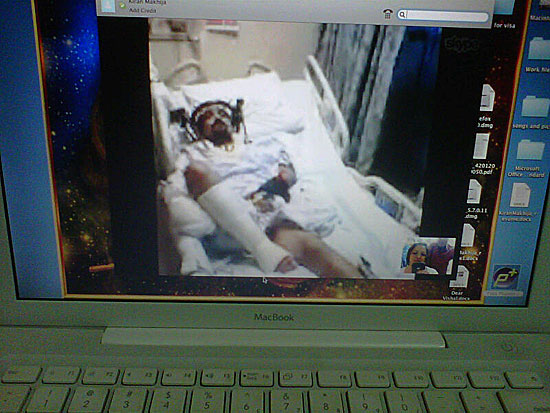
Makhija Skypes with his sister in India, Kiran Makhija, who has lined up a nurse, a physical therapist and a specialized hospital bed for him.
Posted 1/16/13





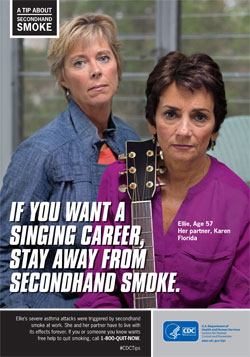

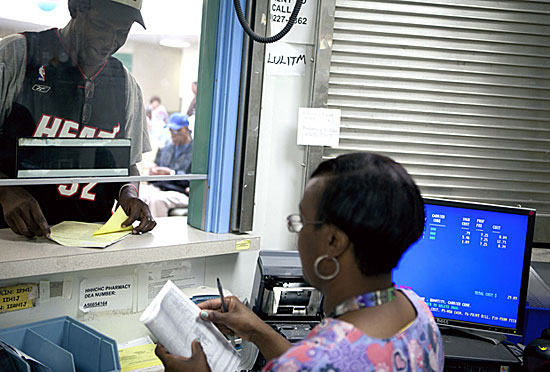
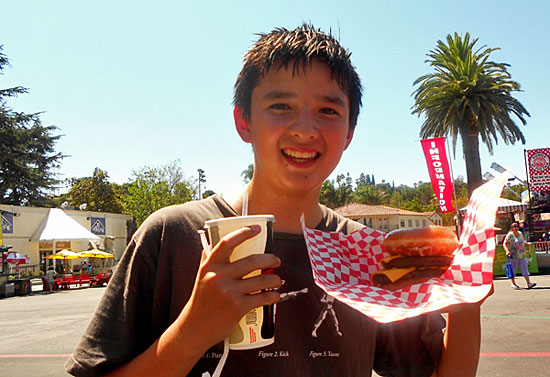
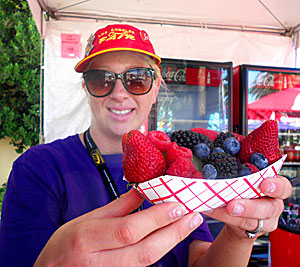

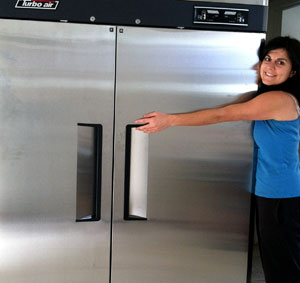



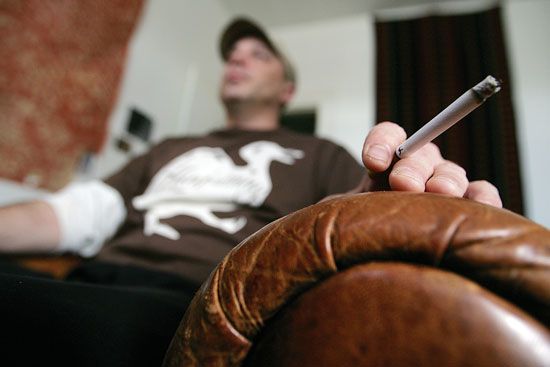
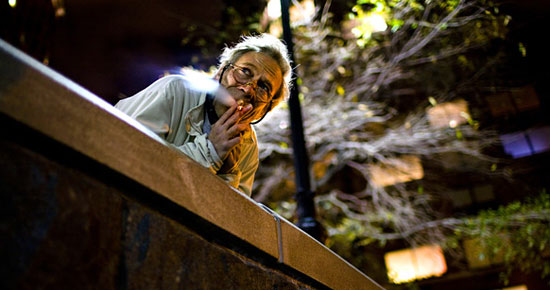
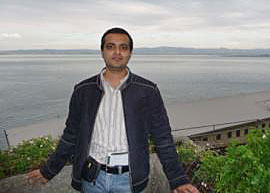
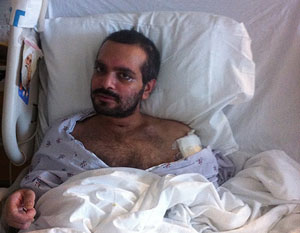







 405 bridge work causes a stink
405 bridge work causes a stink
